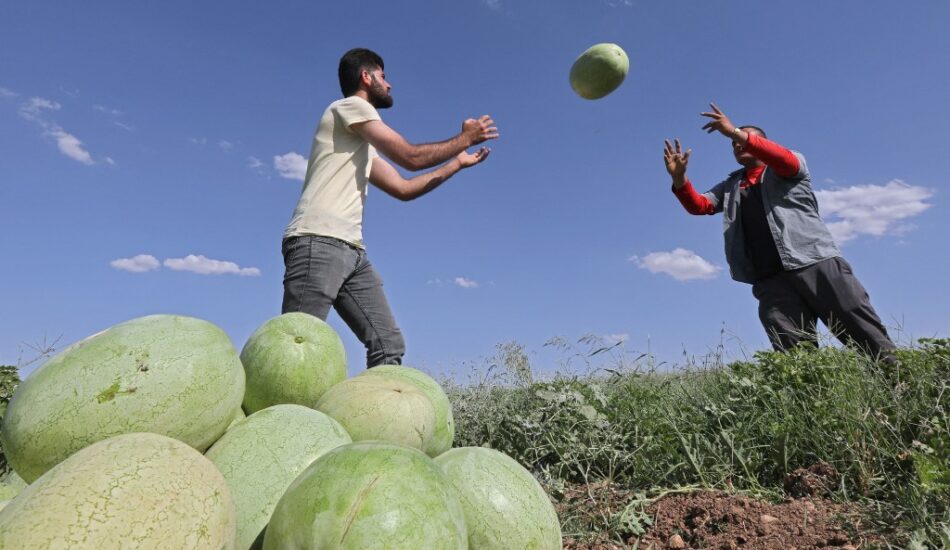
Current water use
The vast majority of water in Iraq is used for agriculture. In 2017, out of the 43.07 BCM of water withdrawn for human use, 87.8% was used for agriculture, 2.5% for industrial uses and 2.7% for municipal water supply (Figure 1).[1] After a strong increase in industrial water use in the 1990s and early 2000s, the deterioration of Iraqi industry following the 2003 US invasion, civil war and conflict with the Islamic State in Iraq and Syria (ISIS) led to the reversal of the trend and the current low industrial water use.[2]
Groundwater is primarily used in the agricultural sector, with some use for industrial and municipal purposes where groundwater quality allows. A total of 20 official irrigation projects rely on groundwater to support irrigation as well as other irrigation projects in the western desert. More than 88,000 wells are located across the country, supplying families, cities and industries with water, although detailed information about consumption rates is not always available. There is also an undetermined number of illegal wells.[4]
In addition to the traditional human uses, i.e. agriculture, industry and municipal water supply, water needs to be set aside for environmental uses as well, particularly for the restoration and maintenance of the Mesopotamian Marshes. These environmental uses are estimated at 10-20 BCM/yr. An additional 8-12 BCM/yr of surface water are lost to evaporation from reservoirs.[5]
Projected water use and supply deficit
Demand is set to outpace supply in the near future if Iraq does not embark on major reforms of the water sector.[6] Exact estimates of the expected water deficit are difficult due to a lack of data, however, one report estimates a deficit of 10-20 BCM/yr by 2030, which would correspond to approximately one-third of Iraq’s water demand.[7]
Infrastructure deterioration and leakages, an outdated irrigation and drainage water collection system, perverse incentives in farm subsidies, and use of fresh water for oil well re-injection (instead of more sustainable alternatives like treated wastewater) are all areas that must be addressed if Iraq is to meet its projected water needs over the next 20 years.
Agricultural water use and irrigation development
Agriculture is mostly practised on small farms and is a relatively low-input, low-output system, meaning limited technology is used and consequently crop yields and economic gains are low. The poor quality of available agro-chemicals together with the misuse and scarcity of organic fertilizers also limit crop yields. Moreover, the obsolescence of farm machinery and inadequate technical skills of most farmers contribute to poor productivity.
The agricultural sector consumes most of Iraq’s overall water resources, with approximately two thirds of cultivated land under irrigation, particularly in the semi-arid and arid parts of the country. The high water use is also due to low irrigation efficiency at an estimated 30-40%, largely due to water losses from irrigation canals and the use of inefficient flood irrigation.[8]
The high dependency on irrigation water also means that when a drought occurs, agriculture is among the sectors hit the hardest. For example, in 2008 and 2009, drought damaged almost 40% of Iraq’s cropland, and Ninewa and Erbil experienced damage to over 50% of their cropland. Compounding the threat of drought, the cultivated land requiring irrigation for wheat alone expanded by 33% between 2000 and 2010.[9]
Reducing water use
In 2014, the Ministry of Water Resources adopted an aggressive strategy on water resources management in order to sustainably address the country’s water needs. If fully implemented, this strategy will bring about a 24.5% decrease in freshwater consumption by 2035, even as Iraq’s population grows.[10]
A large part of this decrease is in freshwater consumption by the agricultural sector. The strategy outlines new cropping patterns and crop mixes according to agroclimatic zones, on-farm water use efficiency increases to 70%, conveyance efficiencies to 90% and operational efficiency increases to 95% to achieve an overall irrigation efficiency of 60%. If those gains are made, the surface water consumption in the sector would decrease by over 30% from 2015 to 2035.[11]
Implementation of the outlined reforms was, however, hindered by the emergence of ISIS in Iraq in 2014 as well as economic challenges linked to the drop in global oil prices in 2015. As a result, few reforms were realized during the 2010s. The Ministry of Water Resources is planning to update the strategy in 2023, adjusting the previous document to account for issues such as climate change and damage done to water infrastructure by ISIS.[12]
[1] FAO (Food and Agriculture Organization of the United Nations), 2022. AQUASTAT database.
[2] Dunia Frontier Consultants, 2013. Water and Sewage Sectors in Iraq: Sector Report – February 2013.
[3] Sarant, L, 2013. ‘Massive loss of fresh water in Middle East revealed’. Nature Middle East.
[4] Sarant, L, 2013. ‘Massive loss of fresh water in Middle East revealed’. Nature Middle East.
[5] Japan International Cooperation Agency, 2016. Data Collection Survey on Water Resource Management and Agriculture Irrigation in the Republic of Iraq; Dunia Frontier Consultants, 2013. Water and Sewage Sectors in Iraq: Sector Report – February 2013.
[6] Walker, K, 2014. ‘In Iraq, fresh water may soon be a thing of the past’. Published by The National on 16 March 2014.
[7] Alwash, A, Istephanian, H, Tollast, R and Al-Shibaany, Z Y (eds), 2018. Towards Sustainable Water Resources Management in Iraq. Iraq Energy Institute.
[8] Japan International Cooperation Agency, 2016. Data Collection Survey on Water Resource Management and Agriculture Irrigation in the Republic of Iraq.
[9] Ministry of Water Resources of Iraq, 2014. Strategy for Water and Land Resources of Iraq 2015-2035.
[10] Ibid.
[11] Ibid.
[12] The World Bank estimates it will take over $200 million for the reconstruction and recovery of the damaged water infrastructure from ISIS.
